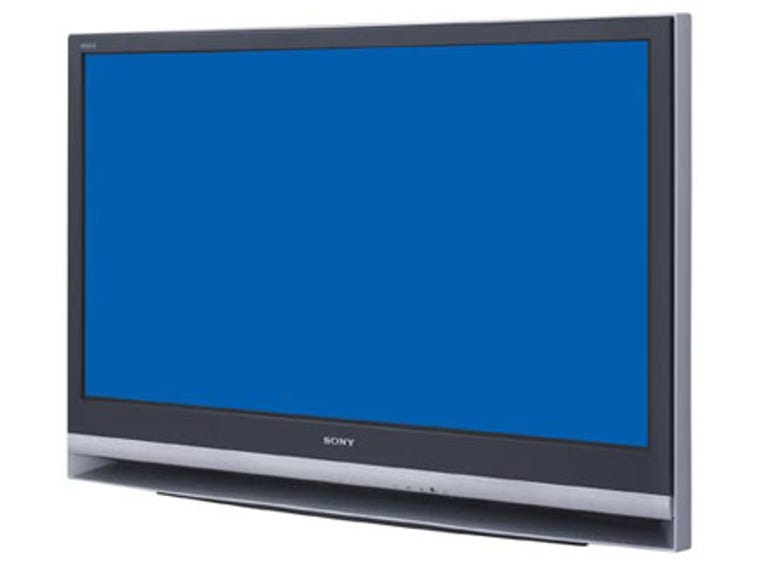 Why You Can Trust CNET
Why You Can Trust CNET Sony Grand Wega 42-inch (KFE42A10) review: Sony Grand Wega 42-inch (KFE42A10)
Sony's LCD rear projection Grand Wega TV presents good images but the price point comparative to similar technologies makes this a hard product to recommend.
Design
The Grand Wega KFE42A10 is a deceptive little TV unit -- although at 999mm x 722mm x 357mm, little is perhaps not the right word. As with most rear projection units, the size of the TV tells you absolutely nothing about the weight, which comes in at a svelte 27kg. The size of the KFE42A10 means you'll still need two people to lift it out of the box, but doing so is surprisingly easy. Once you've got it installed -- and its depth, while much better than that of older rear projection units, still means that this is a TV suitable for free-standing or sitting in a cabinet -- you'll find it imposing in all but the largest home living rooms. Like the older 60-inch Grand Wega KFWS60S1, the style of the KFE42A10 is largely understated, with a centralised Sony logo on the base of the bezel, which is itself encased in a silver plastic frame. As with most black-bezeled TVs, the intended effect is to maximise the perceptible screen size by focusing the eye directly at the screen. As this is a rear-projection unit, that's doubly wise -- but more on that later.
The Good
The Bad
The Bottom Line
The side of the KFE42A10 houses simple AV inputs -- for home game consoles and the like -- while the rear houses a full array of connections, from composite all the way up to HDMI. The supplied remote is very large and very well laid out. You could just about lose it down the side of a sofa, but you'd have to try very hard indeed.
Features
The KFE42A10 uses a 3-LCD Rear Projection bulb with a top projected resolution of 1280 x 720 pixels. Technically, it's 3 times 1280 x 720 pixels, as the projector uses three 1280 x 720 pixel panels in red, green and blue respectively. Still, the overall resolution is one that's actually a touch lower than the older (and costlier) 60-inch Grand Wega set, which topped out at 1366 x 788 pixels. Our review of the older 60-inch model noted that sadly that model came with dual tuners, but only analog ones -- and nothing's changed in 2006, with the KFE42A10 sporting similar dual tuners. There's just nothing to make a good screen seem like a crappy one quite like looking at analog TV images on it.
Like the other Grand Wega TVs -- there's a similar 50-inch model (the KFE50A10) that will set you back an extra AU$1000 -- the KFE42A10 uses Sony's Wega image engine for improved image quality, along with what Sony calls "Cinema Black" technology. This is a contrast circuit that controls the light output of the display during dark scenes in order to deliver optimal black levels -- something that's not always easy with a projected image. The 1280 x720 is compatible with 1080i/720p/576p and 480p digital signals, although as noted above, you'll need a seperate digital TV tuner in order to take advantage of these resolutions for broadcast television.
The other major feature that Sony pitches with the KFE42A10 is the use of its Wega Gate interface. This is a very simple, cut-down menu option straight from the remote that makes adjusting screen size, brighness, tuner and other TV functions simple for novice users.
Performance
Like most rear projection TV units, you'll have to wait a while when you first power up the KFE42A10, as it takes about half a minute for any type of clear image to come up onscreen from a cold start. Confusingly, audio starts up much quicker, which can be interesting if you're using the TV to entertain young children.
The displayed image on the KFE42A10 was of a very high quality indeed for a rear projection unit. There is one catch with the KFE42A10, and it's a failing that's seen in most rear projection displays. Because the light output on the screen sends directly out in a more or less straight line from the lens, the best images are seen when facing the KFE42A10 directly. If you're off-angle, either from the sides or above or below, the loss of light intensity makes the image significantly more dull. At an angle of around fifteen degrees in a reasonably bright room, we found the image essentially vanished.
The other catch against the KFE42A10 -- and it's certainly a bigger one than viewing angles, which are an issue for most rear projection TVs -- is the asking price. AU$3,000 for a 42-inch TV might seem like a very good price, until you realise that pressure in the display marketplace, especially in plasma, has driven prices down to around that level for "genuine" flat panel displays. Several vendors have launched 42-inch plasmas at the AU$3,000 price point, and a little haggling in the sales room should see other models drop there before long. The KFE42A10 boasts a higer display resolution than most of those budget-range plasmas -- but it's significantly bulkier than any of them, and unsuitable for wall hanging to boot. It's thus a little hard to enthusiastically recommend the KFE42A10, at least until the price drops a little in line with the rest of the market.


